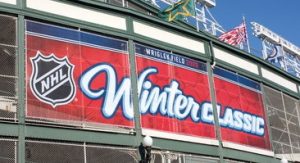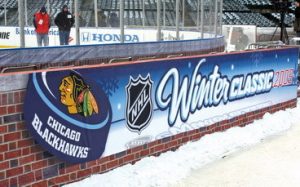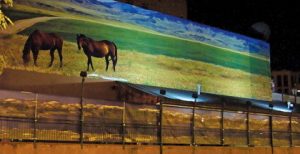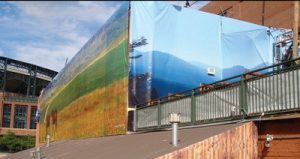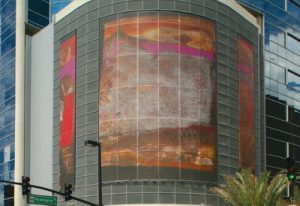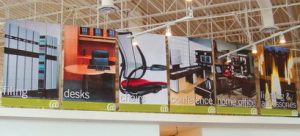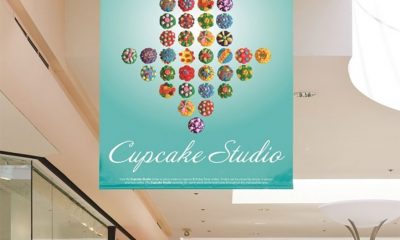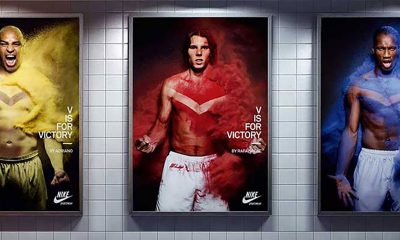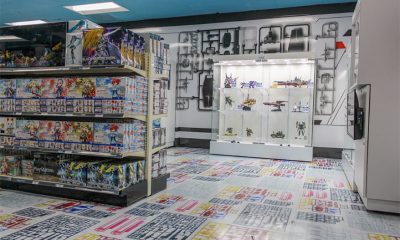Banners + Awnings
A Banner Season
A look at diverse soft-sign graphics
Published
15 years agoon
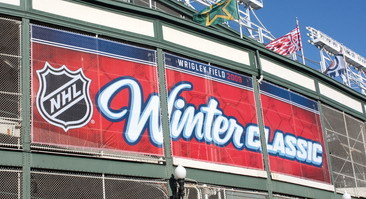
Centuries ago, banners held tremendous significance. They were a central part of church’s liturgical proceedings, and identified warring nations, clans or tribes as they charged headlong into battle.
Although hand-rendered banners are still used for religious purposes, and recreational groups like the Society for Creative Anachronism raise them during their medieval reenactments, banners now make their most profound statements commercially (and, they’re printed via inkjet or screenprinting processes instead of being rendered in vegetable dyes, milk or ox blood, as in olden times).
Although soft-sided signs have always been valued as an inexpensive advertising tool, the following projects underscore banners’ evolution from routine storefront signage that promotes a sale or new product into dramatic backdrops and prominent architectural statements.
Take Me Out to the…Rink?
For the second consecutive year, the National Hockey League (NHL) has celebrated the sport’s roots in playing outdoors, by holding the Winter Classic, a New Year’s Day tilt played al fresco between the Chicago Blackhawks against the Detroit Red Wings. The NHL staged the game at Chicago’s Wrigley Field, legendary home of the Cubs.
AdvertisementBerkeley, CA-based Flying Colors reprised its role as designer and fabricator for the Winter Classic’s banner graphics. David Kerchman, Flying Colors’ president, Kerchman quickly decided on the design for in-stadium graphics; although Wrigley’s famed red-brick wall might have been snow-covered and its cover of ivy dormant at face-off, he brought these images into mid-spring splendor. He and his team visited Wrigley during baseball season to gain a better sense of the genuine article, and created the likeness using Adobe® Photoshop® and Illustrator® software.
“[Wrigley’s] red brick and ivy are registered landmarks with the Illinois Historical Register, and baseball fans the world over know them as icons of one of the game’s legendary park,” Kerchman said. “This event focuses as much on the venue as the game itself, and I couldn’t think of a better way to pay homage to the stadium.”
However, he noted that Wrigley offered several logistical hurdles.
“The ballpark’s almost 100 years old, and doesn’t have concourses that you associate with more modern stadia,” he said. “Also, because it’s not normally used in winter, the water pipes were turned off to prevent freezing, and there was no heat to be found.”
To counteract Wrigley’s lack of operational space, Kerchman’s team constructed a scaffold parallel to the outfield wall, which created a makeshift corridor that enabled back-of-house access for Flying Colors, as well as broadcasting staff and NHL officials. This scaffold also provided the structural basis to allow Flying Colors the opportunity to recreate Wrigley’s famed outfield wall.
As expected in the Windy City, the weather played havoc with the installation schedule. However, fate provided an unseasonably warm day the Saturday before the game, and Flying Colors worked around the clock to meet the deadline. Because of the numerous trades involved in constructing the rink, broadcasting positions and numerous other projects, a very tight schedule allowed little leeway.
AdvertisementThe differing conditions of each graphic installation required different material and printing solutions. For the exterior banner and centerfield roof scaffolding, which encountered considerable wind loads, Kerchman specified Ultraflex’s 7-oz., PVC-coated vinyl/polyester mesh. Flying Colors decorated these banners with its EFI-VUTEk 5300 solvent-ink printer.
To decorate the temporary fence that provided security for the outdoor plazas and compounds, Flying Colors created a 1,300-sq,-ft. wrap using Verseidag seemee’s perforated, knitted-polyester banner mesh that it embellished with a Zimmer flatbed, automatic-press screenprinter.
To wrap the scaffolding and broadcast platform, fabricators used the same knitted-mesh fabric used for the fence wrap. They decorated the system using a Digitex dye-sublimation press. The dasher-board graphics, which presumably endured some wear and tear from defensemens’ hard forechecks, and other installations that required non-perforated substrates, Flying Colors used DuraKnit polyester decorated by the Digitex printer.
Kerchman was pleased to have another opportunity to create Winter Classic graphics: “Success in this business can certainly be attributed to building successful relationships. Open, effective communications with the customer is a must, as is flexibility and a commitment to meeting deadlines. And, executing at a very high level on our creative, fabrication and installation disciplines is paramount to truly feeling successful on a project such as this.
Blue Country
AdvertisementPolitical conventions always serve as touchstones for party faithful to reconnect with kindred spirits who, at least in theory, share their values. Last summer’s Democratic National Convention in Denver carried a particularly high energy level as “blue” sympathizers rallied behind Barack Obama’s nomination.
Although these conventions serve to unify adherents, Montana Democrats wanted to stake out a venue for themselves. To celebrate Big Sky Night, they rented out Jackson’s Sports Rock, a bar adjacent to Invesco Field, the conventions’ home base, and hired bluemedia (Tempe, AZ) to bedeck its exterior walls with banner depicting rustic scenery befitting the Treasure State.
According to bluemedia’s Chris Keal, the project designer, the client provided more than 200 slides taken by a Montana photographer that depicted Montana scenery, and he selected and fine-tuned the graphics using Photoshop and Illustrator, and prepped them for printing using Onyx Graphics’ ProductionHouse® RIP.
They selected a 12-oz., glossy banner media. Keal said bluemedia likes to use mesh to conserve weight, but they had to conceal the building’s existing mural. All told, bluemedia fabricated 40 banners whose total area approximated 9,000 sq. ft. The largest piece entailed 3,000 sq. ft.; installers used a Miller Weldmaster® hot-air welding system to join the vinyl panels together.
“Wrestling the material up to the roof and making sure it was level and secure on a breezy day proved to be the most challenging part of the project,” Keal said. “After that, it was a matter of carefully using torches and hand tools as we would for any installation.”
To print the banners, they used the shop’s recently acquired HP Turbojet TJ 8300, which he credits with allowing bluemedia to execute high-volume production runs efficiently with high quality.
The Centre of Attention
Orlando, FL-based Sundance Architectural Products designs and installs awnings, metal canopies, louvers and other tensioned-fabric structures. The company undertook a high-profile project when it agreed to create a five-story wrap to bedeck the parking garage at Orlando’s Dynetech Centre, a 30-story, ultra-modern, luxury high-rise on Orlando’s outskirts that offers office and apartment space. Lincoln Property Co., the facility’s management company, provided Ivan Bermudez, Sundance’s graphic manager, wiith digitally rendered artwork.
“The parking structure had a raw, unfinished appearance, and [Lincoln Property Co., the facility’s manager] wanted to hide them with sophisticated artwork,” Bermudez said.
To hang the wrap, which stretched 45 ft. long and as wide as 32 ft. in some sports, Sundance constructed custom aluminum frames and brackets. The graphics were produced using Ultraflex’s Ultralon 20-oz. mesh fabric on an EFI-Vutek 5300 printer and used radio-frequency welding to join the panels. Installers stretched the wrap’s corner panels around the structure’s metal-grill façade to make it flow with the architecture, Bermudez says. To enliven the wrap’s nighttime appearance, accent lights were installed above and below the art panels to complement the integral, parking-structure illumination.
“I think our panels offer the Dynetech an artistic feel that would make it at home in any large city,” Bermudez said.
Office Décor
Bluemedia (Tempe, AZ) produced this series of 4 ft. x 6 ft. 2 in. banners for At the Office, a high-end, Phoenix-based furniture store. After receiving the artwork and layout from Graphique Communications Design (Scottsdale), which contracted the shop to fabricate the program, bluemedia reviewed material possibilities and decided to print the program on its HP Turbojet TJ8300 with Ultraflex material.
“Because the end user was an upscale office-furniture store, we chose a matte-finish product because we wanted minimal glare so it wouldn’t look like a typical, shiny banner,” Mike Greco, a bluemedia sales rep, said.
When installers arrived onsite, they encountered some installation challenges. They planned to suspend them from square, steel hardware from the ceiling and secure them with pole pockets, but, after hanging one banner this way, Graphique Communications asked for a different approach. Thinking quickly, they decided to use connect the banner from the ceiling using Velcro and attaching pole pockets at the bottom, which the customer approved. Because of the store’s compact environs, bluemedia used a scissor lift to negotiate the area.

SPONSORED VIDEO
Introducing the Sign Industry Podcast
The Sign Industry Podcast is a platform for every sign person out there — from the old-timers who bent neon and hand-lettered boats to those venturing into new technologies — we want to get their stories out for everyone to hear. Come join us and listen to stories, learn tricks or techniques, and get insights of what’s to come. We are the world’s second oldest profession. The folks who started the world’s oldest profession needed a sign.
You may like

Orbus Celebrates Earth Day With Recycling Achievements

American Sign Museum Names New Executive Director

3 Things Print Pros Must Do to Build Stronger Relationships in the Interiors Market
Subscribe

Bulletins
Get the most important news and business ideas from Signs of the Times magazine's news bulletin.
Most Popular
-

 Tip Sheet1 week ago
Tip Sheet1 week agoAlways Brand Yourself and Wear Fewer Hats — Two of April’s Sign Tips
-

 Photo Gallery3 days ago
Photo Gallery3 days ago30 Snapshots of the 2024 ISA Sign Expo
-

 Ask Signs of the Times4 days ago
Ask Signs of the Times4 days agoWhy Are Signs from Canva so Overloaded and Similar?
-

 Real Deal2 weeks ago
Real Deal2 weeks agoA Woman Sign Company Owner Confronts a Sexist Wholesaler
-

 Benchmarks1 week ago
Benchmarks1 week ago6 Sports Venue Signs Deserving a Standing Ovation
-

 Women in Signs2 weeks ago
Women in Signs2 weeks ago2024 Women in Signs: Megan Bradley
-

 Photo Gallery1 week ago
Photo Gallery1 week ago21 Larry Albright Plasma Globes, Crackle Tubes and More
-

 Women in Signs1 week ago
Women in Signs1 week ago2024 Women in Signs: Ashley Borell
